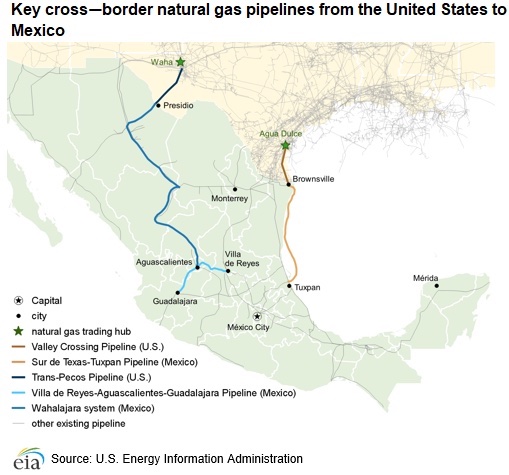Natural gas exports from the United States to Mexico surpassed 7 billion cubic feet per day (Bcf/d) on multiple days during June, according to pipeline data from Wood Mackenzie. The record high for the month was 7.4 Bcf/d on June 24. Increased power demand, high temperatures, and greater industrial demand, combined, drove the increased demand for natural gas. New pipeline additions have helped facilitate the increased volume of natural gas flowing to natural gas-fired power plants, industrial plants, and pipeline interconnections throughout Mexico.
Natural gas pipeline exports from the United States to Mexico averaged 6.9 Bcf/d for June 2021, according to Wood Mackenzie estimates, which was a year-on-year increase of 25% and a 44% increase compared with the five-year (2016-20) average. Most of the increase can be attributed to greater flows on two cross-border pipelines: the Sur de Texas-Tuxpan Pipeline, which has a capacity of 2.6 Bcf/d and delivers natural gas from the U.S. border at Brownsville, Texas, to Tuxpan in Veracruz, Mexico; and the Trans-Pecos Pipeline (part of the Wahalajara system), which has a capacity of 1.4 Bcf/d and delivers natural gas to the U.S. border at Presidio, Texas.

The Wahalajara pipeline system, which connects the Waha Hub in West Texas to Guadalajara and other population centers in West-Central Mexico, has had increased flows coming from the Trans-Pecos Pipeline from about 0.2 Bcf/d in June 2020 to an estimated 0.8 Bcf/d in June 2021. Some of the increase on the Wahalajara pipeline system is from the increased flow capacity on the Villa de Reyes-Aguascalientes-Guadalajara Pipeline (VAG) in Central Mexico and subsequent delivery points that entered service upon its completion in October 2020.
With increased access to natural gas imports, Mexico has increased its use of natural gas to generate electricity. Seasonally high temperatures in areas of northern and central Mexico during parts of June increased demand for electricity. Natural gas-fired power generation in Mexico was up 19% in June compared with last year. About 4.9 Bcf/d of natural gas was used for power generation in June 2021, compared with 4.2 Bcf/d in June 2020 and 4.4 Bcf/d in June 2019, according to Wood Mackenzie data.
Natural gas used for industrial purposes also contributed to the increased natural gas demand in June. Industrial sector natural gas demand reached 3.3 Bcf/d in June 2021, up 31% from June 2020, largely driven by the recovery from COVID-19 and the related economic effects.
Over the past few years, Mexico has relied increasingly on imported natural gas from U.S. pipelines. Pipeline imports accounted for 76% of Mexico’s total natural gas supply in June 2021, up from 40% in June 2015. Both domestic production and imports of liquefied natural gas (LNG) have been declining as a share of Mexico’s total natural gas supply.









